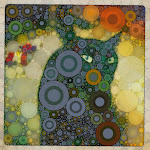 My love affair with baked egg custard goes back a lo-o-ong way, to my childhood. My paternal grandmother, the one who lived on a farm her entire life, used to keep some in the refrigerator, which was the first place I'd head when we visited.
My love affair with baked egg custard goes back a lo-o-ong way, to my childhood. My paternal grandmother, the one who lived on a farm her entire life, used to keep some in the refrigerator, which was the first place I'd head when we visited.There's something so comforting in this easily-digested treat, made at its simplest with just eggs, milk, and sugar.
Now that I'm all grown up, I find myself still craving this childhood treat, but wondered if I could adapt it to be free of dairy and sugar. This led to some internet research, where I learned that egg custard can be made with coconut milk. I am fortunate to have inherited my grandmother's custard cups, and mixed the custard in my mother-in-law's old Pyrex glass mixing bowl (the kind that came in four colors in graduated sizes), which added a note of nostalgic satisfaction to the process.
For the first batch I made, last summer, I steeped crushed lemongrass in some warmed coconut milk, strained it out, then proceeded to add eggs, vanilla, and a pinch of salt. While not as creamy as a traditional custard, it was pretty tasty, especially paired with fresh berries.
I had been experimenting with combining unsweetened cocoa powder and mashed banana in things like muffins, and that became the base of this latest experiment. The addition of some extra-spicy Vietnamese cinnamon added a lot of flavor.
These custards have more the texture of a panna cotta than a traditional, gelatinous baked egg custard, but they satisfied my craving just fine.
Baked Chocolate Egg Custard
makes 6
5 large eggs
1/2 teaspoon vanilla
1 cup well-mashed very ripe banana
1/3 cup unsweetened cocoa powder
1 teaspoon ground cinnamon (I used strong Vietnamese cinnamon)
1 cup coconut milk
Preheat oven to 325° F, with a rack in the center of the oven.
Combine banana, cocoa and cinnamon and mix well to blend. Set aside.
Beat eggs, vanilla, and a pinch of salt until slightly frothy. Whisk in the banana-cocoa mixture and mix well.
Divide custard between 6 custard cups or individual ramekins. Place in larger pan, then pour hot water into the larger pan until it is halfway up sides of custard cups.
Bake 30-45 minutes or until knife inserted in center comes out clean. Be careful not to overbake. Remove custard cups from water bath; let cool 10 minutes, then cover with plastic wrap and refrigerate.





